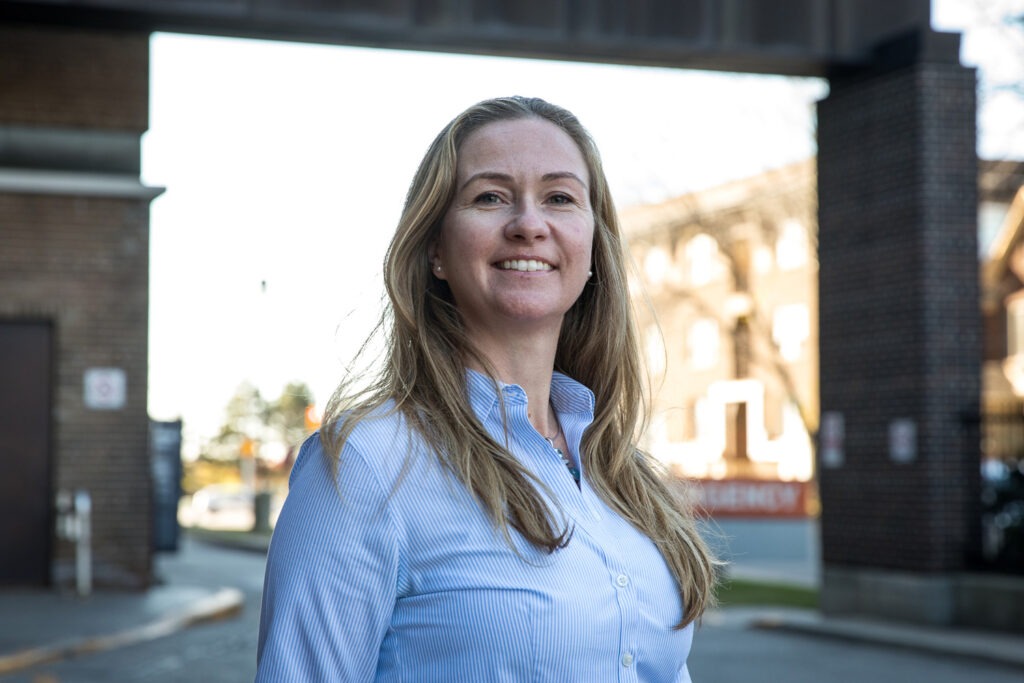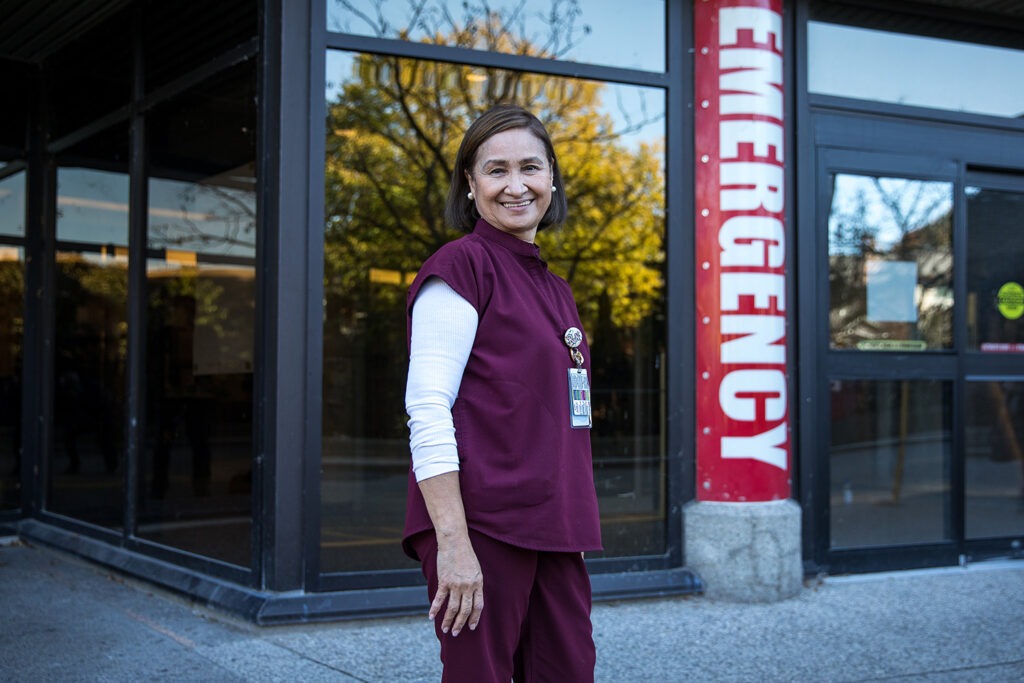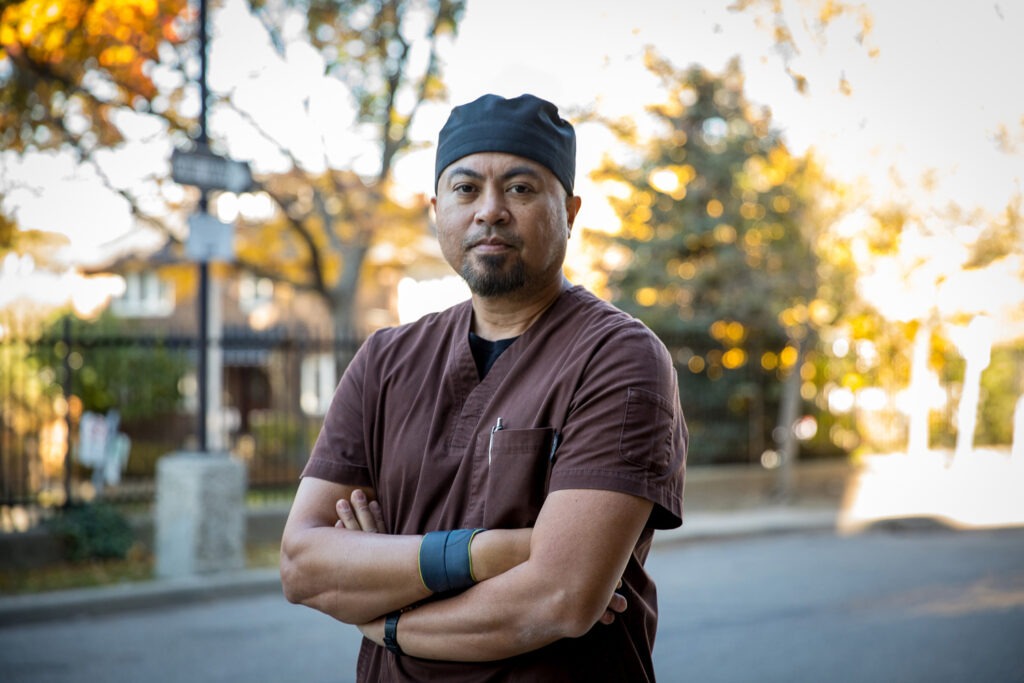How St. Joseph’s is getting patients the care they need faster

Ana, Alice, Sarah and Mel, are leaders at St. Joseph’s who work together to make sure patients get the care they need when they need it. (Credit: Eduardo Lima)
Over the course of the last year, St. Joseph’s Health Centre significantly reduced the length of time admitted patients wait in the emergency department (ED) for an inpatient bed by more than a third – a feat made possible by creativity, leadership and an all-hands-on-deck approach.
In the wake of system pressures and human health resources challenges exacerbated by the pandemic, access to timely care across the health system decreased. In health care, ‘access and flow’ often refers to processes that move inpatients through a hospital from the moment they arrive to when they leave and their care transitions to the community. The team at St. Joseph’s focused their efforts on access and flow, and the ED length-of-stay for admitted patients improved from a peak weekly average of 43 hours in August 2022 to 25 hours in mid-October 2023.
While the reduction is significant, more work is underway – and needed – at Unity Health and across the system to further reduce the time patients wait in the ED. Bringing down this statistic means that patients in urgent need access care faster, ambulances offload patients more quickly and can get back on the road, and the path is paved for more efficient movement of patients throughout the whole system. As hospitals prepare for an annual winter surge, these numbers will continue to change. However, the past year has marked an important shift in the St. Joseph’s site’s approach to working together to manage flow.
“What we started with on this journey is to make sure that we understand each other’s roles across units,” said Giancarla Curto-Correia, the Patient Care Manager of the 2L Medicine unit at St. Joseph’s.
“Between the ED and Medicine, really we are one team. We understand what the goals are and work together. It’s always centred on the patient.”
As Ana Anjema, Operations Leader for the ED, describes it – the ED is a gateway to the hospital, but it is not “landlocked.” Every patient admitted in the ED will need to be placed in an inpatient bed on another unit tailored to the care they need. For this to happen quickly, everyone is involved.
The Access and Transitions team is key to this collaboration.
“Some people liken our team to the air traffic controller,” said Sarah Rydahl, the manager of Access and Transitions.

“We identify where beds are throughout the hospital and figure out the right bed for the right patient at the right time. Then we talk to teams about what their capacity is to take a patient – it’s about working together to encourage flow.”
Together is the operative word when it comes to efforts in access and flow.
In September 2022, Unity Health established a task force dedicated to access, flow and transitions. Comprised of frontline staff, Patient and Family Advisors, and leadership, the task force has helped enable key work. The group created a unified “escalation protocol” for times when a large number of patients are waiting in the ED and there aren’t enough available inpatient beds for them. They’ve also supported work led by the Quality Improvement and Operational Excellence team to better understand a patient’s journey to an inpatient bed, and supported projects to streamline each step.
This, in concert with unit-level efforts made by the ED and Medicine teams, has contributed to changes at the St. Joseph’s site.
The ED teams at St. Joseph’s and St. Michael’s have created designated ambulance offload spaces, their own internal overcapacity practices, and maximized spaces to provide patient care. At St. Joseph’s, Anjema says the opening of the Yellow Zone, an area launched in October 2022 that added 12 more patient treatment spaces for ambulatory patients in the ED, has made an important difference.
“This is really the area where people can come in and out and we’re trying to drive shorter lengths of stay,” she said.

While slow flow can look like an overcrowded ED, on the Medicine units it can also cause issues, explains Alice Feruelo, Team Leader on 4L Medicine. Safety concerns can arise when a patient is moved to a unit or service that isn’t appropriate for them.
To help with access and flow and avoid this, the Medicine units have also made changes. For example, they have promoted a culture where any nurse can ‘take report,’ or accept a summary of a patient who is about to be admitted to the unit from the ED.

“Usually, the ED is calling up to a specific nurse, but if that person is busy or on a break it creates a delay,” said Marcella Honour, the Patient Care Manager on 4L Medicine.
“Whereas if any nurse takes report, then the patient can come to the unit. And now we’ve worked hard to eliminate that delay whenever possible. It’s really about partnership with the ED and efficiently getting patients where they need to go.”
They’ve also created a touch base meeting for operations leaders from the different teams to come together and share learnings on access, flow and transitions. Mel Ibana, Team Leader for 2L Medicine, credits the creation of transition-oriented roles on units with speeding up patient flow.

“We’ve been able to hire frontline staff to look at the discharge piece,” he said. “Without them, things would fall apart.”
Improving the way patients move through a hospital is all about taking problems that seem insurmountable and breaking them up into smaller, more achievable goals, as the teams across St. Joseph’s have done, says Rydahl.
“It doesn’t seem like such a mountain to climb when we all take a small slice of the pie. We’re all working towards the same goal, and that’s to help the patients and our community,” she said.
“Getting patients out of an ambulance, into the ED, then onto a unit will help them get the care they need and get those ambulances out on the road to help the community. Helping flow happen from a system perspective is just another way to give back to our community.”
By: Ana Gajic
